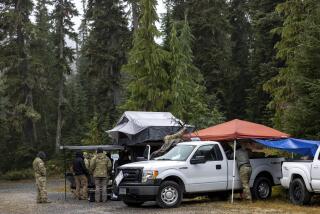Recalling the WASPs : WWII Woman Pilot Keeps Memories of Unit Alive
- Share via
HUNTINGTON BEACH — Fifty years ago, Violet (Vi) Cowden served in the Women Air Force Service Pilots program, flying P-51 Mustangs and other fighter planes of World War II.
Cowden and other women pilots flew planes fresh off factory assembly lines to embarkation points in California and New Jersey, freeing their male counterparts to fly combat missions.
The 1,074 women who won their flight wings flew 60 million miles in service to their country. They ferried planes, towed targets, laid smoke screens for training exercises, simulated bombing missions and performed flight tests, among other duties.
Thirty-eight died in the line of duty. About 750 are still alive today, Cowden estimates.
The story of the women pilots needs telling because their contribution “barely” made it into history books, Cowden, 76, of Huntington Beach, said in a recent interview. The reason? “We are women and men write the history,” she said.
To keep the memory of the WASPs alive, Cowden travels to schools, colleges and military bases to speak about her wartime experiences. Her next speaking date is Feb. 18 at Knott’s Berry Farm, where she will address a retired military officers’ group.
Cowden was a 26-year-old first-grade teacher in Spearfish, S.D., and had earned a private pilot’s license when she joined the WASPs in early 1943.
“I joined because of love for the country,” she said. “And I thought maybe I could contribute something to the war effort.” She also more than doubled her salary, from $110 to $270 a month.
One of her toughest challenges came even before she signed up. She had to gain weight to meet the 100-pound requirement in order to pass her physical. She weighed 92 with only seven days to go to the weigh-in, but she stuffed herself with bananas and water and was able to make the weight requirement, she said.
In 50 years, she’s added only five pounds, she said.
Cowden flew 19 types of aircraft with the WASPs, she said. The P-51 was her favorite because it was the fastest and sleekest of the lot, she said.
Once she got her P-51 up to more than 400 m.p.h. when she raced a Navy pilot from Columbus, Ohio, to Newark, N.J., she said. “I stayed ahead of him all the way,” she said.
Cowden said women pilots are at least equal to and “maybe a little better” than males and should be allowed to fly combat missions if they desire.
“They’re more sensitive and steadier,” she said. “The airplane can’t tell the difference between a man or a woman.”
Her busiest times came in 1944 when the United States was gearing up for the D-Day invasion of Normandy. She worked seven days a week, from sunup to sundown, flying fighter planes from factories in Texas to an embarkation point in New Jersey and then catching the next commercial plane for the return flight to her home base in Dallas to repeat the process.
“For two weeks, the only sleep I got was on (commercial) airplanes,” she said. “We had the highest priority (on commercial flights). Only the President of the United States could bump us.”
The Women Air Force Service Pilots program was dismantled on Dec. 20, 1944, a day that Cowden calls one of the saddest of her life.
“The war was winding down and the men were coming back and wanted their jobs back,” she said. “I felt a lot of resentment.”
Though Cowden and her fellow WASPs completed the same flight training as male pilots and were accorded military privileges, they were, in fact, civil service employees, not military personnel. The WASP program was experimental and developed too quickly to be incorporated into the military, she said.
When women fliers were killed, colleagues took up a collection to send the body home because the government didn’t help, she said. Former WASPs didn’t receive veterans’ benefits until 1977, she said.
After the WASPs, Cowden entered the ceramics business in Lynwood. Eventually she operated the Teachers Resource Center in the Huntington Beach City School District, where she helped develop reading games and other programs. She retired 12 years ago.
She and her husband, Scott, have a daughter and two granddaughters.


